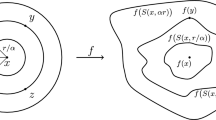Abstract
We interpret some results of persistent homology and barcodes (in any dimension) with the language of microlocal sheaf theory. For that purpose we study the derived category of sheaves on a real finite-dimensional vector space \(\mathbb {V}\). By using the operation of convolution, we introduce a pseudo-distance on this category and prove in particular a stability result for direct images. Then we assume that \(\mathbb {V}\) is endowed with a closed convex proper cone \(\gamma \) with non empty interior and study \(\gamma \)-sheaves, that is, constructible sheaves with microsupport contained in the antipodal to the polar cone (equivalently, constructible sheaves for the \(\gamma \)-topology). We prove that such sheaves may be approximated (for the pseudo-distance) by “piecewise linear” \(\gamma \)-sheaves. Finally we show that these last sheaves are constant on stratifications by \(\gamma \)-locally closed sets, an analogue of barcodes in higher dimension.
Similar content being viewed by others
Notes
\(\mu {\mathrm{supp}}(F)\) was denoted by \({\text {SS}}(F)\) in Kashiwara and Schapira (1990).
See Sect. 2.4 for related constructions.
In practice the cone \(\gamma \) will be polyhedral.
As already mentioned, these results were clarified during discussions of the second named author with Nicolas Berkouk.
This statement is due to Curry (2013, Th.4.2.10).
References
Bauer, U., Lesnick, M.: Persistent diagram as diagrams: a categorification of the stability theorem (2016). arXiv:1610.10085
Bubenik, P., Scott, J.: Categorification of persistent homology. Discrete Comput. Geom. 51, 600–627 (2014). arXiv:1205.3669
Bubenik, P., de Silva, V., Scott, J.: Metrics for generalized persistence modules. Found. Comput. Math. 15, 1501-1531 (2015). arXiv:1312.3829
Chazal, F., Cohen-Steiner, D., Glisse, M., Guibas, L.J., Oudot, S.: Proximity of persistence modules and their diagrams. In: Proc. 25th, ACM Sympos. on Comput. Geom., pp. 237–246 (2009)
Chazal, F., de Silva, V., Glisse, M., Oudot, S.: The Structure and Stability of Persistence Modules (Springer, ed.). Springer, Berlin (2016)
Cohen-Steiner, D., Edelsbrunner, H., Harer, J.: Stability of persistence diagrams. Discrete Comput. Geom. 37, 103–120 (2007)
Crawley-Boevey, W.: Decomposition of pointwise finite-dimensional persistence modules. J. Algebra Appl. 14, 1550066, 8 pp (2014). arXiv:1210.0819
Curry, J.M.: Sheaves, cosheaves and applications (2013). arXiv:1303.3255v2
Edelsbrunner, H., Harer, J.: Persistent homology – a survey. Surv. Discrete and Compute. Geom. Contemp. Math. 453, 257–282 (2008)
Ghrist, R.: Barcodes: the persistent topology of data. Bull. Am. Math. Soc. 45, 61–75 (2008)
Goresky, M., MacPherson, R.: Stratified Morse Theory, Ergebnisse Der Mathematik Und Ihrer Grenzgebiete, vol. 14. Springer, Berlin (1988)
Guibas, L., Ramschaw, L., Stolfi, J.: A kinetic framework for computational geometry. In: Proc. IEEE Symp. on Foundations of Computer Science, pp. 74–123 (1983)
Guillermou, S.: The three cusps conjecture (2016). arXiv:1603.07876
Guillermou, S., Kashiwara, M., Schapira, P.: Sheaf quantization of Hamiltonian isotopies and applications to nondisplaceability problems. Duke Math. J. 161, 201–245 (2012)
Guillermou, S., Schapira, P.: Microlocal theory of sheaves and Tamarkin’s non displaceability theorem. LN of the UMI, pp. 43–85 (2014). arXiv:1106.1576
Kashiwara, M.: On the maximally overdetermined systems of linear differential equations I. Publ. Res. Inst. Math. Sci. 10, 563–579 (1975)
Kashiwara, M.: The Riemann–Hilbert problem for holonomic systems. Publ. RIMS Kyoto Univ. 20, 319–365 (1984)
Kashiwara, M., Schapira, P.: Sheaves on Manifolds, Grundlehren der Mathematischen Wissenschaften [Fundamental Principles of Mathematical Sciences], vol. 292. Springer, Berlin (1990)
Lesnick, M.: The theory of the interleaving distance on multidimensional persistence modules. Found. Comput. Math. 15, 613–650 (2015)
Lesnick, M., Wright, M.: Interactive visualization of 2-d persistence modules (2015). arXiv:1512.00180
Oudot, S.: Persistence Theory: From Quiver Representations to Data Analysis, Mathematical Surveys and Monographs, vol. 209. AMS, Providence (2015)
Schapira, P.: Operations on constructible functions. J. Pure Appl. Algebra 72, 83–93 (1991)
Tamarkin, D.: Microlocal conditions for non-displaceability (2008). arXiv:0809.1584
Acknowledgements
The second named author warmly thanks Gregory Ginot for having organized a seminar on persistent homology, at the origin of this paper, and Benoît Jubin for fruitful discussions on this subject. In this seminar, Nicolas Berkouk and Steve Oudot pointed out the problem of approximating constructible sheaves with objects which would be similar to higher dimensional barcodes, what we do, in some sense, here. Moreover, the links between \(\gamma \)-sheaves and persistent modules (Proposition 2.15) were clarified during discussions with Nicolas Berkouk.
Author information
Authors and Affiliations
Corresponding author
Additional information
The research of M.K was supported by Grant-in-Aid for Scientific Research (B) 15H03608, Japan Society for the Promotion of Science. The research of P.S was supported by the ANR-15-CE40-0007 “MICROLOCAL”.
Rights and permissions
About this article
Cite this article
Kashiwara, M., Schapira, P. Persistent homology and microlocal sheaf theory. J Appl. and Comput. Topology 2, 83–113 (2018). https://doi.org/10.1007/s41468-018-0019-z
Received:
Accepted:
Published:
Issue Date:
DOI: https://doi.org/10.1007/s41468-018-0019-z




